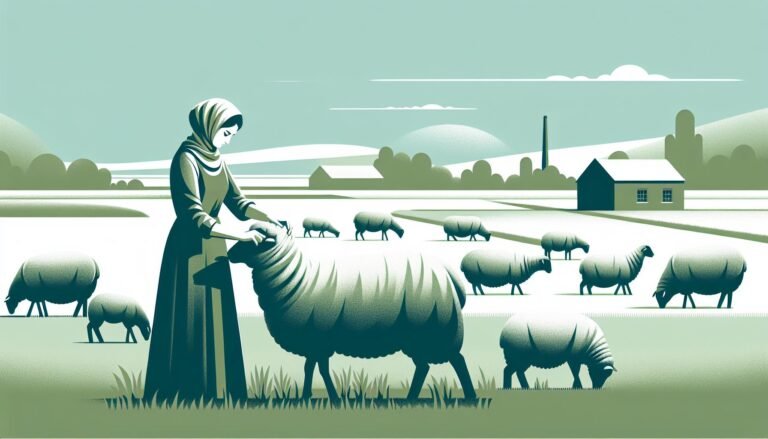What is a Wool Picker?
In the vast realm of fiber arts, tools play a pivotal role in shaping the final product. Among these tools, the wool picker stands out as a cornerstone for those passionate about working with fleece. This comprehensive guide will take you on a journey through the intricacies of wool pickers, their features, and the steps to use them effectively.
History of Wool Pickers
Before diving into the specifics, it’s essential to understand the historical context of wool pickers. These tools have been around for centuries, aiding artisans in preparing wool for various uses. From the ancient civilizations that recognized the value of wool to the modern-day fiber artists, the wool picker has evolved in design but remained consistent in its purpose.
Evolution of Wool Picker Tools
In ancient times, wool picking was done manually using rudimentary tools made of wood and bone. Over the centuries, as technology advanced, so did the tools. Today’s wool pickers are a blend of tradition and innovation, ensuring efficiency without compromising on the quality of wool.
Ancient Techniques vs Modern Methods
While ancient techniques relied heavily on manual labor and took longer, they had their own charm and produced uniquely textured wool. Modern methods, on the other hand, prioritize speed and uniformity. Both have their merits, and it’s fascinating to see how the balance between the two is maintained in today’s world.
The Science Behind Wool Picker
At its core, wool picking is a science. It’s about understanding the nature of wool fibers and ensuring they are separated and aligned perfectly.
What is Picking Wool?
Picking wool is a crucial step in the fiber preparation process, primarily aimed at separating and fluffing up the locks of wool. This process ensures that the wool fibers are free from any tangled clumps, dirt, or impurities. By using a wool picker, the fibers are teased apart, making them more manageable and easier to card or spin. The act of picking not only enhances the quality of the wool by aligning the fibers but also prepares it for subsequent stages in textile production. Whether done manually or with specialized equipment, picking wool is an essential practice that ensures the production of soft, lustrous, and high-quality yarns and fabrics.
| Equipment | Description |
|---|---|
| Picker | A Picker is used to separate the locks of wool before it is carded or spun. It teases the fibers in bulk and quicker than what can be done by hand. It’s possible to spin fibers directly after the picking stage, but often they are carded and blended with other fibers first. |
| Blending Boards | Using a Blending Board is akin to painting a picture with fiber. It results in unique rolags which simplify spinning novelty fibers. They are portable and ideal for carding fiber “on the road”. |
| Hand Carders | Hand Carders are used to process various fibers, from dog hair to llama to wool, to get them ready for spinning. They align the fiber for spinning, felting, or weaving. |
| Drum Carder | Drum Carders are larger versions of hand carders. They usually consist of two drums, and the fiber is wound through these drums, turning it into a batt, which can be used for spinning, felting, etc. |
| Combs | Combs are another way of processing fiber that aligns the fibers in a parallel manner. The type of comb required depends on the type of fiber being processed, ranging from alpaca to cashmere to various types of wool. |

Features of a Wool Picker
1. Variety of Options
The world of wool pickers offers a plethora of choices. From the traditional Box Pickers to the more modern Swing Pickers, each type has been designed keeping specific needs in mind. The Box Picker, for instance, is known for its robust design and efficiency, while the Swing Picker offers more flexibility in handling different fleece types.
2. Efficiency in Fleece Preparation
The primary objective of a wool picker is to streamline the fleece preparation process. By separating out the fibers, it ensures that the wool is ready for carding, spinning, or any other subsequent processes. This efficiency not only saves time but also ensures a higher quality end product.
3. Versatility
A wool picker’s versatility is one of its standout features. Whether you’re dealing with a rare fleece type from a specific breed of sheep or a more common variety, the tool is equipped to handle it all. Its design ensures that irrespective of the fleece’s origin, the results are always optimal.
4. Durability
Given the rigorous nature of fleece preparation, wool pickers are built to last. High-quality materials combined with superior craftsmanship ensure that these tools can withstand regular use without any significant wear and tear.
Steps to Use a Wool Picker
- Selection: The first step involves choosing the right wool picker. Research the different types available and select one that aligns with your needs.
- Preparation: Before introducing the fleece to the picker, ensure it’s clean. Remove any debris or contaminants that might affect the picking process.
- Picking: Feed the fleece into the wool picker gently. Ensure a steady motion to allow the tool to work its magic efficiently.
- Collection: After the picking process, gather the separated fibers. These are now ready for the next stages of your fiber art journey.
Maintenance of Wool Pickers
Like any tool, wool pickers require regular maintenance to function optimally. Cleaning after each use, ensuring no fibers are stuck in the mechanism, and occasional oiling can go a long way in prolonging the life of your wool picker.
Why is a wool picker essential in fiber arts?
A wool picker simplifies the fleece preparation process, ensuring the fibers are separated and ready for subsequent stages.
How often should I clean my wool picker?
It’s advisable to clean your wool picker after each use to ensure its longevity and efficiency.
Can I use the same wool picker for different fleece types?
Yes, a wool picker’s versatility allows it to handle various fleece types effectively.
What’s the difference between a Box Picker and a Swing Picker?
While both serve the same purpose, a Box Picker is known for its robust design, whereas a Swing Picker offers more flexibility in handling.
Can I make a DIY wool picker at home?
Yes, there are many resources and tutorials available for those interested in making a homemade wool picker. However, safety precautions are crucial.
What’s the future of wool pickers?
With continuous technological advancements, the future looks promising. We can expect more efficient, eco-friendly, and innovative wool pickers in the coming years.
Conclusion
The wool picker, though a simple tool, holds immense significance in the world of fiber arts. Its features, combined with the right techniques, can transform the quality of your work. Whether you’re a beginner just stepping into this world or a seasoned artist, understanding and effectively using a wool picker can elevate your creations to new heights.







